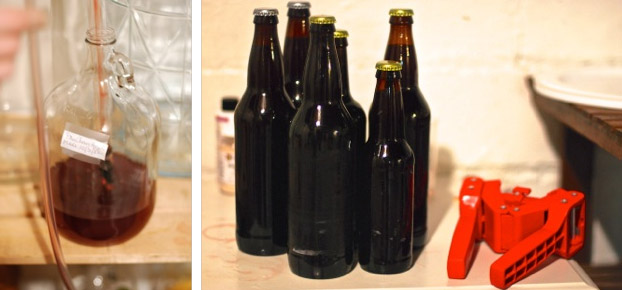
Ingredients:
16 lbs tart apples
10 lbs sour pie cherries
3 lbs honey (1 quart)
7 cups sugar
2 tbs citric acid
2 tbs yeast nutrient or 1 cup raisins
2 gallons boiling water, plus more cold water for topping off
2 pkgs Lavin 47 wine yeast or other wine yeast
Special Equipment:
6 gallon fermenting bucket with lid & airlock
6 gallon filter bag (or sanitized large pillow case)
extra long spoon
bottling bucket with hose and bottle spigot
new or used beer bottles
new beer caps
bottle capper
Instructions:
Clean all of your equipment, buckets, bottles, countertops, knives, spoons, food processor, blender, filter bag, etc (anything that will come into contact with the wine during the process) with dish soap and hot water, and rinse well. Then rinse everything, including surfaces, with either StarSan sanitizing solution (per package directions) or a very week solution of 1 tbs bleach to 1 gallon of water. Leave wet for StarSan or air dry ahead of time with bleach solution. Make sure your hands are clean, too!
Line your fermenting bucket with the filter bag and secure the top so it doesn’t slip. Wash and core your apples, cutting out any bad spots. Leave the skins on. Pit the cherries. (Save the pits for cherry pit vodka!) In a food processor with the grater attachment, grate all the apples. Place into your filter bag. Next, with the processor blade, blend all your cherries. Add to the filter bag.
To the bag add the honey, sugar, acid, yeast nutrient or raisins, and boiling water. Stir with your long spoon. Add additional cold water to bring the level up to 5-5.5 gallons. Be sure to leave at least 4 inches of headspace in your fermenting bucket or it may “blowout” when the fermentation kicks in. It needs some room to bubble. Stir the mixture well to incorporate air and blend in the sugars.
Check the temperature. When it reaches 80 degrees or less, add 1 package of yeast. Stir again. Tie your filter bag off with butcher’s twine (sanitized), then add the lid, along with an airlock filled with vodka or Star San solution. Place the bucket in a location that’s around 68-72 degrees, which in my case, was my kitchen. Fermentation should start within 24 hours. You’ll know because your airlock will start bubbling up gasses that smell very pleasant. Fermentation at proper temp should take about 1-2 weeks.
If you’ve read my post on Yellow Tomato Wine, you’ll note that I have not added Campden tablets to this mix to neutralize wild critters. This is because I’m gambling a little with the wild yeasts that live on the apples and cherries themselves. I recently tasted some wild fermented beer from Minnesota, made by the brewer at Barley Johns, and it was funky-sour-awesome goodness. So this may be a little bit of “Minnesota Nice” worked into the mix. You still want everything else to be clean, though. No sense in adding nasty kitchen bacteria to the mix.
After the primary fermentation has slowed to a crawl, about 1 bubble per minute in the airlock, you can “rack” your wine. Racking means that you remove the solids in the filter bag and syphon off the main liquid from the sludge at the bottom, into a secondary fermenter, or in this case, a clean, sanitized 5 gallon glass carboy bottle. Seal this with a rubber bung and a fresh airlock filled with vodka or StarSan. Let the cider sit at least one month, then taste it to see if you like it. If it’s good, move on to bottling. If not, let it sit another month. There are often harsh flavors and ethers that soften with time. You may need to rack this again if more sediment accumulates. If you like the cider as is, you have still wine. Or you can bottle and carbonate it to make sparkling cider.
Now it’s time to bottle and get natural carbonation going! You will need washed and sanitized beer bottles (not the screw top kind) and new bottle caps and a bottle capper. Or you can use bail and rubber seal bottles, like the kind Grolsch beer comes in. Rack your cider into a sanitized bottling bucket. Add 2/3c honey mixed with a little warm water to the cider and stir with a clean spoon. Next sprinkle in the second package of yeast if your cider is over a month old. Your cider has been sitting around so you don’t want to run the risk that your old yeast is dead. Stir well. Fill your beer bottles to within an inch of the top, then cap. Let the bottles ferment in a moderate temp location for 2-3 weeks. Test a bottle to see if it’s carbonated. When ready, refrigerate all the bottles, or make sure they are in a very cool part of your basement. Bottles have been known to explode if they over carbonate. Refrigeration will prevent that. When you’re ready to drink your cider, pour it into a glass, leaving any sediment behind in the bottle. All my supplies came from Northern Brewer, which also has great online resources and books. And enjoy!